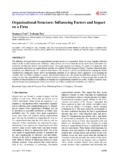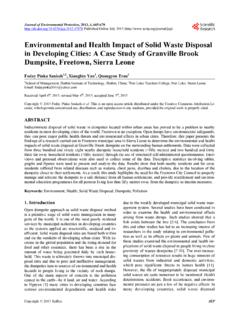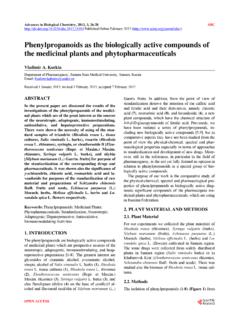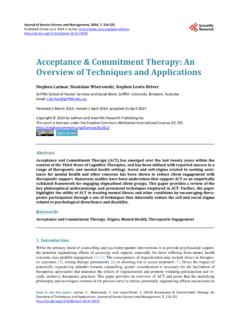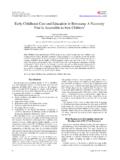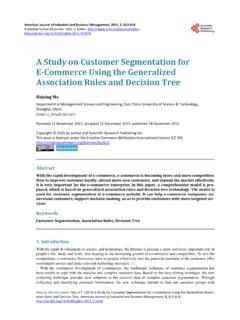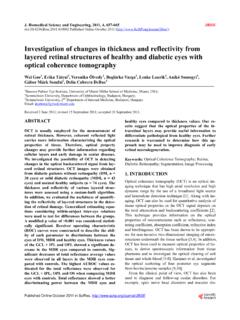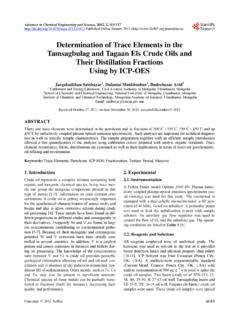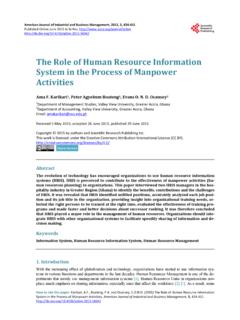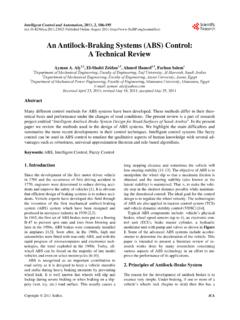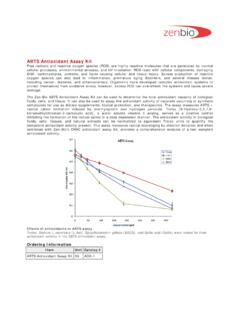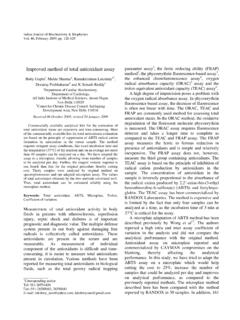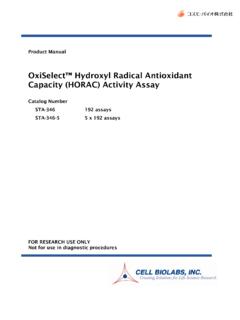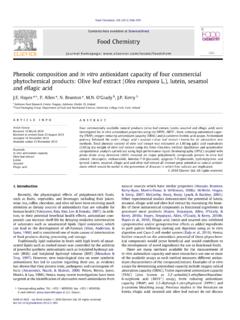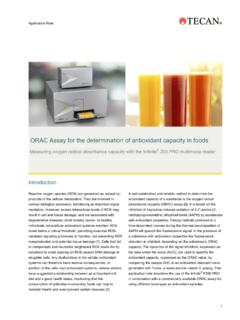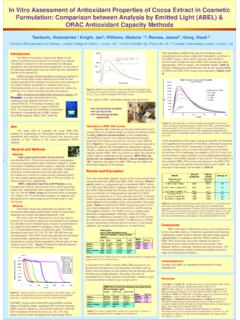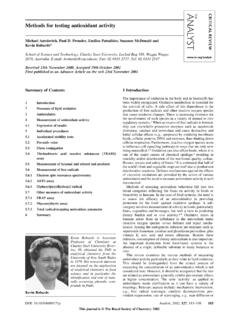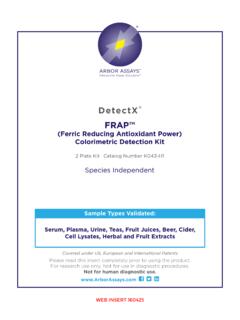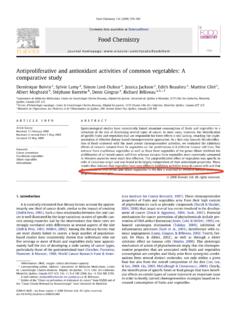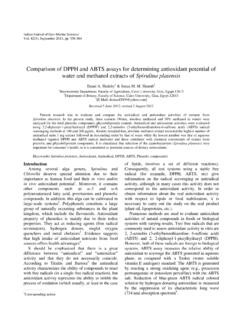Transcription of Comparison of Total Phenolic Content and Total Antioxidant ...
1 Food and Nutrition Sciences, 2014, 5, 1660-1667 Published Online September 2014 in SciRes. How to cite this paper: B y ktuncel, E., Porgal , E. and olak, C. (2014) Comparison of Total Phenolic Content and Total Antioxidant Activity in Local Red Wines Determined by Spectrophotometric Methods. Food and Nutrition Sciences, 5, 1660-1667. Comparison of Total Phenolic Content and Total Antioxidant Activity in Local Red Wines Determined by Spectrophotometric Methods Ebru B y ktuncel1, Esra Porgal 1, Cemil olak2 1 Department of Analytical Chemistry, Faculty of Pharmacy, University of Inonu, Malatya, Turkey 2 Department of Biostatistics, Faculty of Medicine, Inonu University, Malatya, Turkey Email: Received 22 June 2014; revised 26 July 2014; accepted 7 August 2014 Copyright 2014 by authors and Scientific Research Publishing Inc.
2 This work is licensed under the Creative Commons Attribution International License (CC BY). Abstract In this study, the Antioxidant activity of local red wines was determined by four different analyti- cal methods: 1,1-diphenyl-2-picrylhydrazyl (DPPH) radical scavenging assay , 2,2'-azino-bis-(3- ethylbenzothiazoline-6-sulfonic acid) (ABTS +) radical cation decolourisation, ferric reducing/antio- xidants power (FRAP) and cupric ion reducing capacity in the presence of neocuproine (CUPRAC) for the evaluation of reducing power (PR). They were correlated with the Total Phenolic Content (TPC) determined with the Folin-Ciocalteu s reagent using gallic acid as a standard.
3 The Total po- lyphenol concentration was found to vary from to mg/L gallic acid equivalents (GAE). The Total Antioxidant activity determined by DPPH, ABTS, FRAP and CUPRAC methods was found to vary from - mmol/L, - mmol/L, - mmol/L and - mmol/L, respectively. The Total Phenolic contents of red wine samples exhibited a good cor- relation (p < ) with Antioxidant properties. Keywords Red Wine, Antioxidant Activity, Total Phenolic Content , DPPH, ABTS, FRAP, CUPRAC 1. Introduction antioxidants are substances that, at low concentrations, prevent or retard the oxidation of easily oxidisable bio- molecules such as lipids, proteins or DNA. They counteract free radicals and thus prevent oxidative damage [1] E.
4 B y ktuncel et al. 1661 [2]. There are two basic categories of antioxidants , namely, synthetic and natural. The interest of natural antioxidants has increased in recent years because of their presumed safety and potential nutritional and thera- peutical effects [3]. Epidemiological studies indicated that a higher level of natural antioxidants (vitamins, caro- tenoids, phenolics) in human everyday diet can protect against cardiovascular diseases, cataract, cancer and ag- ing-related disorders [4]. Among natural antioxidants , red wine has attracted particular interest due to a high Content of biologically active compounds [3]. Phenolic compounds are one of the most important quality para- meters of wines, and they contribute to organoleptic characteristics such as color, astringency, and bitterness [5].
5 These compounds are also active in biochemical processes and have nutraceutical effects on human health, in- cluding antimicrobial, anticarcinogenic, and Antioxidant properties [6]. Consequently, numerous papers have focused on the determination of Antioxidant capacities of wines and correlation with their polyphenol Content [5]-[12]. Several in vitro methods have been developed to measure Antioxidant capacities of food, beverages and bio- logical samples. The most commonly used Antioxidant capacity assays were 1,1-diphenyl-2-picrylhydrazyl radi- cal (DPPH ) assay [13], 2,2-azino-di-(3-ethylbenzothialozine-sul phonic acid) (ABTS) assay [14], ferric ion re- ducing Antioxidant power (FRAP) assay [15] [16], cupric ion reducing capability (CUPRAC) assay [17] and oxygen radical absorbance capacity (ORAC) assay [18] [19].
6 These methods differ from each other in terms of their assay principles and reaction conditions. Single assay will not accurately reflect all antioxidants . Therefore it is recommended that at least two or all of these assays be combined to provide a full profile of Antioxidant ca- pacity of foodstuff [20]. The main objective of this study was to determine the polyphenolic Content and Antioxidant capacity of local wine samples and to compare the Antioxidant capacity of these samples applying four most widely used spec- trophotometric methods: DPPH, ABTS, FRAP, CUPRAC and to estimate correlation of Antioxidant capacities with Total phenolics. 2. Material and Methods Wine Samples 8 red wine samples were purchased from local stores in Elaz and Malatya (Table 1).
7 Samples were opened, protected against sunlight and stored at 4 C. Analyses were carried out within a few days. Each wine was ana- lyzed 5 times. Chemicals Gallic acid, Folin-Ciocalteu reagent, 2,2-diphenyl-1-picrylhydrazyl radical (DPPH) and 2,2 -azino-bis (3-ethyl- benzothiazoline-6-sulphonic acid)diammonium salt (ABTS) were purchased from Sigma-Aldrich. Trolox (6- hydroxy-2,5,7,8-tetramethylchromane-2-ca rboxylic acid) and 2,4,6-tris(2-pyridyl)-s-triazine (TPTZ) were pur- chased from Fluka. Copper(II)chloride, iron(III)chloride, potassium peroxodisulfate, sodium acetate, ammonium acetate, sodium carbonate were obtained from Merck. 2,9-dimethyl-1,10-phenanthroline was from Acros Or- ganics.
8 All solvents and reagents that are used in this study were HPLC or of analytical grade. Table 1. The wine samples tested. Wine samples Grape variety Year pH Alcohol Content % Location 1 Kalecik Karas 2011 Elaz 2 Kalecik Karas - k zg z 2008 Elaz 3 k zg z 2008 Elaz 4 Karao lan 2008 Malatya (Arapgir) 5 k zg z -Bo azkere 2010 Elaz -Diyarbak r 6 k zg z 2010 Elaz 7 Karao lan 2008 Malatya (Arapgir) 8 k zg z -Karao lan 2008 Malatya (Arapgir) E. B y ktuncel et al. 1662 Equipment absorbance measurements were performed on a UV mini 1240 UV-Visible spectrophotometer (Shimadzu, Japan).
9 Determination of Total Phenolic Content Spectrophotometric determination of the TPC was carried out with Folin-Ciocalteu method as adapted for wine analysis [21] using gallic acid as the standard. This method is based on the reduction of a phosphotungsten- phophomolybdate complex by phenolics to blue reaction products. For the preparation of calibration curve, mL aliquots of 50, 100, 150, 200, 250 and 300 mg/L aqueous gallic acid solutions or mL 20-fold dilution samples of red wines (diluted with 13% (v, v) ethanol) were introduced into a test tube and then 2 mL of 2% so- dium carbonate was added. After incubation for 2 min, mL of Folin-Ciocalteu s reagent (diluted with water 1:1, v/v) was added.
10 After a further 30 min the absorbance was measured at 750 nm using a spectrophotometer. Results were expressed as mg gallic acid equivalents per litre of wine (mg GAE/L). ABTS + radical -Scavenging assay ABTS assay was based on a previously published method with some modifications [14], using Trolox (6-hy- droxy-2,5,7,8-tetramethyl-chromane-2-car boxylic acid), a water-soluble analog of vitamin E as standard. ABTS + radical cation was produced by mixing 7 mM ABTS solution and mM potassium persulfate aqueous solu- tion. This stock solution was kept in the dark at room temperature for 12 - 16 h for incubation. The ABTS + so- lution was then diluted with ethanol (approximately 1:90, v/v) to obtain an an absorbance of at 734 nm.
